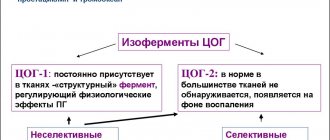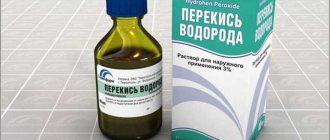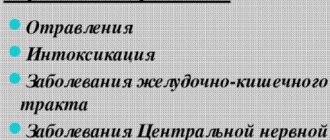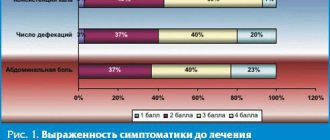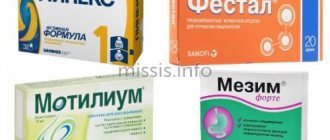Nausea and vomiting are the most common side effects of cancer chemotherapy. The risk of vomiting after administration of different chemotherapy drugs varies widely. Drugs are divided into different groups depending on the severity of nausea and vomiting. Antitumor drugs with a high level of emetogenicity (emetic effect) cause vomiting in more than 90% of patients, a moderate level in 30-90%, a low level in 10-30%, and a minimal level in less than 10% of patients.
The severity of nausea and vomiting depends not only on the specific chemotherapy drug, but also on its dose. Nausea and vomiting more often occurs at a young age, in women, if nausea/vomiting was noted during pregnancy, in cases of low alcohol consumption, or in the presence of vomiting during previous chemotherapy.
According to the timing and mechanism of development, there are three types of nausea and vomiting caused by chemotherapy: acute, delayed and “waiting”, i.e. conditioned reflex.
Acute vomiting develops in the first 24 hours after chemotherapy, is highly intense, and is rarely accompanied by nausea. The main mediator is serotonin (5HT-5-hydroxytryptamine), which is released from enterochromaffin cells of the upper gastrointestinal tract as a result of damage to them by chemotherapy. The interaction of serotonin with specific 5HT3 receptors of the trigger zone of the central nervous system and afferent neurons of the vagus nerve causes afferent pulsation in the vomiting center. As a result of activation of neurons in the vomiting center, nausea and vomiting occur.
An equally important role in the pathogenesis of acute (as well as delayed) vomiting belongs to the neuropeptide - substance P, while the central mechanism of the development of nausea and vomiting predominates. Dopamine D2 receptors, steroid receptors, histamine receptors, etc. also play a certain role in the development of the gag reflex.
In 50% of patients with acute vomiting, delayed vomiting is also observed.
Delayed vomiting develops 2-5 days after the start of chemotherapy, is less intense than acute vomiting, and is usually accompanied by constant nausea. It was first described during treatment with cisplatin at a dose of 120 mg/sq.m. Subsequently, it was found that a number of other chemotherapy drugs also have the ability to cause delayed nausea and vomiting: platinum derivatives, cyclophosphamide, doxorubicin, farmorubicin. The mechanisms of development of this side effect remain unclear. The leading role is given to substance P, serotonin is of lesser importance, damage to the blood-brain barrier and impaired motility of the gastrointestinal tract are possible.
Conditioned reflex vomiting is observed after at least one course of chemotherapy and develops according to the principles of the formation of a conditioned reflex. In the presence of emetic complications during chemotherapy in 30% of patients, by the beginning of the 4th course of treatment o. The best method of preventing this type of vomiting is adequate antiemetic protection, starting from the first course of chemotherapy. For the treatment of conditioned reflex vomiting, psychotherapy and benzodiazepine drugs are recommended.
Vomiting that occurs during adequate antiemetic therapy and requires the use of additional drugs is called uncontrolled. Refractory vomiting is vomiting that occurs despite adequate antiemetic prophylaxis and the use of the entire reserve fund of antiemetic drugs.
Modern antiemetic therapy allows for complete control of nausea and vomiting in 70-80% of patients. The use of combination antiemetic regimens is standard.
ANTAGONISTS OF 5-HT3 RECEPTORS
Ondansetron, granisetron, tropisetron, dolasetron, palonosetron are the most effective antiemetics for the prevention of acute nausea and vomiting. These drugs have low toxicity, causing mainly headache, constipation, and less commonly, diarrhea, dizziness, hypo- or hypertension, transient visual impairment, and weakness. In Russia, mainly three representatives of this group are used: ondansetron (zofran, latran, emeset), granisetron (kytril), tropisetron (navoban, tropindole).
When prescribing 5-HT3 antagonists, it is necessary to take into account a number of clinical characteristics of the drugs:
— the presence of a minimum threshold dose and a “plateau” in the therapeutic effect;
— equal effectiveness of intravenous administration and oral administration;
— equal effectiveness of single and fractional administration.
5-HT3 antagonists have a minimum threshold dose at which the antiemetic effect begins to appear, a gradual increase in the dose is accompanied by an increase in the antiemetic effect, however, when a certain dose is reached, a “plateau” in the therapeutic effect occurs (the maximum possible blockade of 5-HT3 receptors has been achieved) and further increasing the dose does not increase the antiemetic effect.
Thus, 5-HT3 receptor antagonists should be used at the optimal dose. The administration of these drugs in suboptimal doses does not lead to adequate protection against nausea and vomiting; use in doses exceeding the optimal ones is pointless, because does not increase the antiemetic effect.
NEUROKINE RECEPTOR-1 (NK1) ANTAGONISTS
The first and only representative of a new class of antiemetics is the selective NK1 receptor blocker Aprepitant (emend). The drug is available in the form of gelatin capsules, the bioavailability of which is 60-65%, does not depend on food intake, the maximum concentration in plasma is observed after 4 hours, the half-life is 9-13 hours. Aprepitant is metabolized in the liver and eliminated in feces (85%) and urine (5%).
The pharmacokinetics of the drug does not depend on gender, race or age; dosage adjustment is not required in the elderly, as well as in renal or moderately severe liver failure. Pharmacokinetics in persons under 18 years of age has not been studied. When combined with aprepitant, the dose of dexamethasone should be reduced by approximately 50%.
Clinical trials of aprepitant in highly emetogenic chemotherapy showed significant antiemetic activity. The triple combination: aprepitant + 5-HT3 antagonist + dexamethasone had the greatest effectiveness in terms of complete control of both acute and delayed vomiting.
Archives
Short Wiklad
ZA Flake, RD Scalley, AG Bailey Am Fam Physician 2004,69:1169-74,1176
Necessity and vomiting are part of the complex of many illnesses, medical procedures and treatment methods that quickly reduce the severity of life for millions of patients. For those in the United States, the stress of labor and pain wastes 8.5 million workdays. In the United States, pain and vomiting in the postoperative period increase hospitalization costs by $415 per patient. In many cases, the pain of boredom and vomiting is directly due to the blocking of specific, well-trained pathophysiological mechanisms that cause boredom.
Mechanism of action of anti-vomiting drugs
Therapy for boredom and vomiting follows directly to the treatment of the primary illness. Since the etiology is unknown or cannot be corrected, treatment may be symptomatic.
The physiological vomiting center in the brain, which immediately cries out for boredom and vomiting, is stimulated by the three primary pathophysiological pathways (div. Figure 1): vestibular or afferent visceral nerve fibers and subdivisions of chemo. trigger zone receptors on the bottom of the fourth socket of the cerebrum. These processes often involve neurotransmitters such as histamine, acetylcholine, serotonin and dopamine, which is the target of most clinical agents.
Table 1. Anti-vomiting drugs
| Class of drugs | Representatives | |
| Pharmacological name | Trade name, registered in Ukraine | |
| Antihistamines | Buclizin | There are no registrations in Ukraine |
| Cyclizine | There are no registrations in Ukraine | |
| Dimenhydrinate | Aviomarin, Pliva Krakow (50 mg tablets) | |
| Diphenhydramine | Diphenhydramine (tables of 50, 100 mg, amp. 1 ml of 1% solution) | |
| Meclizine | Bonin, 25 mg tablets | |
| Anticholinergic | Scopolamine | Spasmobrew, Brupharmexport (tablets of 20 mg, solution of 20 mg per amp.), Buscocin-M, Monpharm (rectal suppositories of 10 mg) |
| Dopamine antagonism | Chlorpromazine | Aminazine (tables of 25, 50 and 100 mg, amp. 2 ml of 2.5% solution) |
| Droperidol | Droperidol (amp. 2 or 5 ml 0.25% solution) | |
| Metoclopramide | Metoclopramide (10 mg tablet, 2 ml amp of 0.5% solution) | |
| Prochlorperazine | There are no registrations in Ukraine | |
| Promethazine | Pipolfen, Egis (others 250 mg, solution 50 mg per amp.) | |
| Serotonin antagonists | Dolasetron | There are no registrations in Ukraine |
| Granisetron | There are no registrations in Ukraine | |
| Ondansetron | Zofran, GlaxoSmithKline, Emetron, Gedeon Richter (tablets of 4 and 8 mg, solution of 4 and 8 mg per amp.) | |
| Tropisetron | Navoben, Novartis (5 mg drops, solution 2 and 5 mg per amp), Tropisetron-KMP, Kievmedpreparat (5 mg drops), Tropisetron, Biolek (5 mg solution per amp) | |
| Other drugs | Dexamethasone | Dexamethasone, KRKA (tablet. 0.5 mg, solution 4 mg per amp.) and in. |
| Methylprednisolone | Methylprednisolone, Heinz Haupt (tables of 4 and 8 mg) etc. | |
| Trimethobenzamide | There are no registrations in Ukraine | |
Antihistamines and anticholinergic drugs
Antihistamines block histamine at H1 receptors, and anticholinergics block acetylcholine at muscarinic receptors. Both classes of drugs combine stimulation of the vomiting center with the vestibular system (which contains a lot of histamine and acetylcholine), but minimally interfere with afferent visceral stimulation. These drugs are remarkably inexpensive.
For antihistamines, such as meclizine (Antivert), the typical minimal side effects of the central nervous system are: disorientation, congestion, confusion, ringing in the ears, insomnia, poor coordination, etc. mor. Scopolamine is an antimuscarinic drug with effects on the central nervous system. Antihistamines and antimuscarinics may cause anticholinergic side effects, including dry mouth, blurred vision, blurred vision, and narrowed-angle glaucoma. Protein and drugs cause few serious side effects.
Table 2. Main side effects of anti-vomiting drugs
| Class of drugs | Show side effects |
| Antihistamines and anticholinergic drugs | Congestion, blurring of the eyes, impaired vision, narrowing of narrow-cut glaucoma |
| Dopamine antagonism | Hypotension, extrapyramidal manifestations, prolonged QT interval, pronounced hypotension, sometimes - cerebrovascular accidents, agranulocytosis, neuroleptic malignant syndrome, changes in cellular blood supply |
| Serotonin antagonists | Prolongation of the QT interval, QRS, inodes - allergic reactions |
Dopamine antagonism
Dopamine antagonists reduce to a minimum the influx of dopamine onto D2 receptors in the chemoreceptor trigger zone, thereby blocking the expansion of vomit impulses to the vomit center of the brain. Although these drugs are inexpensive and effective, they are characterized by significant side effects, including hypersensitivity, orthostatic hypotension, extrapyramidal symptoms (tardive dyskinesia). Therefore, in certain indications, instead of dopamine antagonists, serotonin antagonists are substituted.
Rare complications due to dopamine antagonists include neuroleptic malignancy syndrome1 and changes in cellular blood supply. Droperidol doses should be administered at prolonged QT intervals; before administration, it is recommended to record an ECG at 12 days. It is believed that droperidol increases the risk of raptic death from cardiac causes, several experts have concluded (Gan TJ et al., 2002; Henzi I. et al., 2000) that this caution is based only on clinical changes, and Randomized controlled studies showed that droperidol is safe and economically effective when administered as an anti-vomiting dose.
1 Manifested by hyperthermia, rigidity and coma. (Note, switch.)
Serotonin antagonists
Selective serotonin antagonisms inhibit serotonin at 5-HT32 receptors in the small intestine, vagus nerve, and chemoreceptor trigger zone, as a result of which the stimulation of the vomiting center of the gastrointestinal tract changes. the brain, which comes from afferent visceral fibers and the chemoreceptor trigger zone. Due to the diffuse blockade of serotonin, these drugs provide superiority in treating the need for various etiologies.
2 5-hydroxytryptamine3.
Serotonin antagonists have emerged as safe drugs with minimal serious side effects. Headache, diarrhea and swelling - the most common side effects - occur regardless of the method of administration and dosing. Allergic reactions occur rarely, but can progress from urticaria to bronchospasm and anaphylactic shock. A small number of patients experience transient elevations in liver enzyme levels.
Clinical studies have revealed that serotonin antagonists cause fairly asymptomatic prolongation of the QT and QRS intervals. Therefore, drugs should be administered carefully in patients with a prolonged QT interval.
Antagonists of 5-HT3 receptors are the newest and most expensive anti-nausea drugs. Three main drugs—ondansetron (Zofran), dolasetron (Anzemet) and granisetron (Kytril)—may have similar effects. Treatment of postoperative fatigue with these drugs in the United States costs $17–195 per dose.
Clinical stasis
Nudota, caused by the vestibular apparatus or pathology of the central nervous system
Anti-vomiting drugs are often used to treat nausea caused by the vestibular system or central nervous system pathology. Instead of other types of boredom, which are caused by the neurotransmitters dopamine and serotonin, boredom, caused by the vestibular system, is caused by histamine and acetylcholine (Table 3). Therefore, the American Gastroenterological Association recommends taking antihistamines and anticholinergic drugs to treat fatigue caused by constipation and sea sickness.
Table 3. The choice of anti-nausea drugs depends on the clinical situation
| Diagnosis | Neurotransmitters | Recommended anti-vomiting drugs |
| Head pain (migraine) | Dopamine (apparently the primary neurotransmitter) | 3 reasons for headaches and headaches: metoclopramide or prochlorperazine 3 reasons for pain: oral anti-vomiting drugs, metoclopramide, prochlorperazine, serotonin antagonists |
| Nudota, caused by the vestibular apparatus | Histamine, acetylcholine | Antihistamines and anticholinergics (equally effective) |
| Nudity, caused by vaginism | Invisible | 3 for the need: ginger, vitamin B6 3 for hyperemesis gravidarum: pipolfen (drug of first choice), serotonin antagonists and corticosteroids (drug of first choice) |
| Gastroenteritis | Dopamine, serotonin | Drugs of the first choice: dopamine antagonists Drugs of the second choice: serotonin antagonists Congestion in children is contraversive |
| Nudity and vomiting in the postoperative period | Dopamine, serotonin | 3rd preventive method: serotonin antagonists, droperidol, dexamethasone 3rd therapeutic method: dopamine antagonism, serotonin, dexamethasone |
Migraine headaches3 are often accompanied by fatigue. Anti-nausea drugs are effective both for the treatment of nausea and headaches, although the mechanism of their action is not entirely known. Some dopamine antagonisms are effective for the treatment of headaches, considering that dopamine is the primary neurotransmitter of this pain syndrome. Follow-up Richman P. V. et al. (2002) found that intravenous administration of droperidol and meperidine (Demerol) is, however, more effective in reducing pain.
3 Div. Also, there is no need for help and preventative treatment for migraines.
— Medicine for the world.
- 1996. - T. 1. - Part 1. - P. 25-31 and Treatment of acute headaches.
— Medicine for the world.
- 2003. - T. 14. - Part 4. - P. 242-250. (Note, switch.)
Recommendations to the committee of the American Academy of Family Physicians, the American Academy of Neurology and other organizations, based on evidence, recommend the use of intravenous metoclopramide and prochlorpera zin - internally, internally and rectally as the first choice drug for patients with acute migraine headache and tediousness. The Committee also found that oral antidiabetic drugs and 5-HT3 receptor antagonists may be used as adjunct drugs for the treatment of fatigue associated with migraine.
Nudity, caused by vaginism4
In 70–85% of women, during the hour of pregnancy, there is fatigue, and in 0.5% of women, excessive vaginal vomiting (hyperemesis gravidarum) occurs. The pathogenesis of boredom is not entirely clear, but we respect that it is not a polyetiological approach. A number of classic anti-vomiting drugs are effective for vomiting syndrome.
4Div. Also the article Schluno-intestinal disorders under the hour of pregnancy. —
Medicine for the world. - 2002. - T. 13. - Part 6. - P. 313-318.
Based on a further review of the literature by Cochrane (2003), anti-nausea drugs are effective in relieving nausea and vomiting, but there is little information about their effects on the patient. Therefore, many doctors do not understand the importance of anti-diabetic drugs, and when dehydration, waste of body fluids, and electrolyte imbalance occur, treatment with pipolfen begins.
Follow-up Sullivan S. A. et al. (1996) showed that treatment with polyphenol in patients hospitalized with hypervomiting was more effective and economical than ondansetron. Subsequently, further research (Safari H. R. et al., 1998) found that methylprednisolone (per os) is effective, less potent, for the treatment of hyperemesis gravidarum and can replace or use other methods and in refractory episodes.
Alternative methods of therapy have also become popular to relieve vaginal discomfort. Pyridoxine (vitamin B6) was found to be safe and effective at dosages of 50–200 mg per day. Additional research Vutyavanich T. et al. (2001) found that oral administration of ginger (1 g per day) is more effective than placebo in relieving nausea and vomiting at the early stage of pregnancy, but ginger is harmless for humans. The evidence for the effectiveness of acupuncture and acupuncture is inconclusive.
Teasing the intestines
Teasing the intestines often causes boredom. Infectious agents such as Norwalk virus, rotavirus, salmonella, cause 1.2% of intestinal infections per person per year. Medications - aspirin, saliva sulfate, digoxin, theophylline and others - can relieve fatigue through cerebral stimulation. Shards of visceral nerve fibers act as neurotransmitter serotonin, and antagonism of 5-HT3 receptors is effective in relieving these disorders.
Relieving boredom in children with gastroenteritis becomes controversial. According to the recommendations of the American Academy of Pediatrics (1996), in children, the use of anti-nausea drugs through potential side effects has shown questionable effectiveness. Most family doctors prescribe 5-HT3 receptor blockers for children with dehydration. Follow-up Ramsook S. et al. (2002) and Reeves JJ et al. (2002) found that oral and internal administration of ondansetron is safe in children and reduces the need for hospitalization.
Nudity and vomiting in the postoperative period
Boredom occurs in approximately 30% of patients following surgery in two pathophysiological ways: 1) intestinal subdivision and postoperative stasis stimulate the vomiting center through visceral nerve fibers, rich in seroton ін; 2) drugs for gastric anesthesia directly activate the chemoreceptors of the trigger zone, which, in turn, stimulate the vomiting center for additional dopamine and serotonin.
Traditionally, dopamine antagonists such as droperidol and polypolfen have been used to treat nausea and vomiting in the postoperative period. Patients with fatigue caused by stasis of chyme in the intestines are primarily prescribed metoclopramide, a drug from the group of dopamine antagonists with prokinetic activity. To relieve fatigue and vomiting in the postoperative period, droperidol in low doses (1.5–2.5 mg for adults, 75 mcg/kg of body fluid for children) is recommended; it is safe, effective and economical, even less Bathing with 5-HT3 receptor antagonists (Henzi I. et al., 2000). Because serotonin antagonists also minimize postoperative discomfort, the American Gastroenterological Association recommends their use as the first choice of drugs to combat postoperative discomfort. from this vomiting and rejoicing. Dexamethasone appears as a complementary drug to serotonin antagonists for the prevention of this syndrome and treatment.
When preparing statistics, also note:
- Gan T. J. Postoperative nausea and vomiting — can it be eliminated? - JAMA 2002 Mar 13;287(10): 1233-6.
- Henzi I., Sonderegger J., Tramer MR Efficacy, dose-response, and adverse effects of droperidol for the prevention of postoperative nausea and vomiting. —Can J Anaesth. 2000 Jun;47(6):537-51.
- Compendium - medicines 2003. - Kiev, 2003.
Prepared by Bogdan Boris
